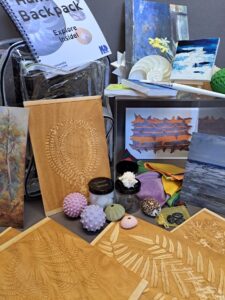Creating a Sensory Backpack at University of Dundee Museums
Museum Engagement Officer Amy Crawford shares how a focus on wellbeing led to the development of a sensory backpack. By taking collections out into the community, this backpack improved access to University of Dundee Museums and facilitated engagement with new audiences.

The project
 Here at University of Dundee Museums we hold many thousands of items in our collections, from herbarium and zoology specimens to artworks and mathematical models. At any one time, we have only a small section of our artefacts on display in the D’Arcy Thompson Zoology Museum, the Tayside Medical History Museum and the exhibition galleries in the Tower Building.
Here at University of Dundee Museums we hold many thousands of items in our collections, from herbarium and zoology specimens to artworks and mathematical models. At any one time, we have only a small section of our artefacts on display in the D’Arcy Thompson Zoology Museum, the Tayside Medical History Museum and the exhibition galleries in the Tower Building.
As part of our Museums for Wellbeing initiative, it was our priority to make our collections more accessible to different audiences. This inspired the creation of a sensory backpack which can be taken out to groups in the local community.
"I found it amazing that the sensory backpack triggered so many happy memories. It was heart-warming to see residents engaged in the way they did."
Activities organiser, Dundee care home
The objects in the backpack were carefully selected to provide a springboard for discussion, recollection, debate and questioning. The objects include custom 3D prints, fabric swatches, and sculpture material samples that relate to other objects in our collections.
We’re incredibly grateful to Museums Galleries Scotland for funding the Museum Engagement Officer post – the sensory backpack is just one of many projects that we’ve been able to develop thanks to this support.
The Sensory Backpack Contains:
- Laser etchings of herbarium specimens
- Perfumes
- Custom 3D prints
- Copies of paintings from the museums collections
- Textured canvases and brushes
- Fabric and stone samples
- Sculpture and handling objects inspired by the museums collections
Challenges and successes
- The sensory backpack gave us an opportunity to showcase our important herbarium collection without risking damage to the original samples. We created custom wooden laser etchings of plants in the herbarium and paired them with perfumes. The scents were effective in evoking memories for certain individuals with dementia – it brought back positive memories for one lady who used to keep a large garden, for example.
- The Covid-19 pandemic hit the care sector particularly hard and activities for residents suffered as external groups were restricted access. The sensory backpack we have created can be either handed in for use between staff/residents or relatives/residents themselves as a shared activity (using an accompanying guidebook). Alternatively, we can come in-person and facilitate a group workshop.
The impact it has made
- The project is only in its infancy but has already reached over 100 people and attracted positive feedback. We are filling up our calendar with different care homes and groups interested and look forward to the future, perhaps workshops with inter-generational learning or school groups.
- If the project remains to be successful, we will look at creating a second backpack with different objects and resources, so we can continue to deliver new and exciting experiences as outreach workshops.
Lessons learned
- Don’t expect to have a discussion with everyone. Some people who are visually impaired or partially hearing may enjoy feeling different textures of objects.
- Expect some people to hate it. It is the nature of anything sensory that not all the objects are going to be for everyone! People may not want to touch or hold items and that must be respected. Some are just content to listen to a story or two, or indeed tell you one!
- Keep an open mind – you might find some unexpected items provoke joy or happiness – it’s all in the workshop delivery.
Guidance
- The objects don’t have to be highly coveted or expensive, important items. If they hold the ability to tell a story or spark memories and relate to your collections, then they are perfect!
- Don’t be afraid to switch it up. Our backpack is constantly reviewed and changed with new objects added as we see fit.
- Make sure your guidebook is an easy to read and larger font. Avoid language that is too complicated.
- Think outside of the box – if you can’t include an object from your collections for any reason then what can you include to represent that object?
- Make sure the objects are easy to sanitise for Covid precautions, as well as making sure to quarantine backpack between uses.
Further information
If you would like more information about this project please contact Amy Crawford at ACrawford001@dundee.ac.uk.
Visit: the University of Dundee Museums website
Further reading: the MGS Report on Museums, Health and Wellbeing